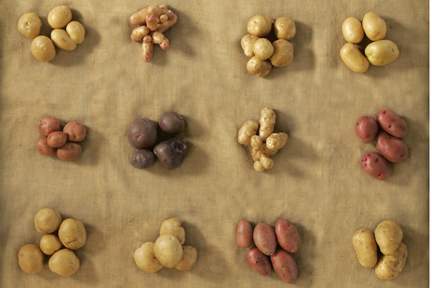Versatile Spuds
A staple of world cuisines, the potato has become a specialty crop in the North Bay
By DIANE PETERSON
THE PRESS DEMOCRAT, October 15, 2008
If there was only one food you could bring to a desert island, what would it be?

Some of the 20 varieties of organic, dry-farmed potatoes from David Little's West Marin farm.
Fred Langley, chef/owner of
“There are so many preparations and ways to eat it,” he said. “I could sustain myself on potatoes.”
At his high-end restaurant,
Since potatoes are harvested throughout the fall, they provide a natural accompaniment to the warming foods of winter. And because they are so nutritious — high in potassium and vitamin C — they can stand alone as a vegetarian entree, especially with a bit of butter, cream or cheese to gussy them up.
“They make you feel warm inside,”
The earthy potato has served as the backbone of cuisines all over the world, sustaining cultures as far flung as
The world is a better place because of dishes like Gratin Dauphinois (French scalloped potatoes), latkes (Jewish potato pancakes), gnocchi (Italian potato dumplings), colcannon (Irish potatoes and kale), tortilla de patatas (Spanish omelette) and Jansson’s Temptation (Swedish potato and anchovy casserole).
Not to mention potato chips and French fries, hash browns and home fries, baked and mashed potatoes (with gravy, of course) here in the United States, where about 10 percent of the world’s potato crop is grown.
The ancient Incas started cultivating the hardy tuber thousands of years ago in
Over its lifetime, the versatile vegetable has crisscrossed the globe, voyaging from the Andes to the French Alps, from the shores of
The frontier families of early
A young botanist named Luther Burbank first discovered a mutation in a plot of potatoes at his home in
Deep in the sandy, loamy soil of western Marin and Sonoma counties, potatoes have been grown since the early 1800s by Irish and Swiss-Italian settlers. Today, potatoes have become a trendy specialty crop in the
To fill that demand, a small but hardy corps of farmers still plant organic spuds in the spring and dig them up by hand from August through November.
Potato farmer David Little, of Little Organic Farms west of
Little uses a dry-farming method, where he discs the grounds, plows, discs again, then he drags a roller over the soil to hold in the moisture. The dry-farming method results in more flavor but less yield.
“Originally it was done because in the early 1800s, there wasn’t a lot of water,” he said. “And they didn’t have the tools to dig deep wells.”
This year, Little’s harvest crew is digging up a bumper crop of fresh potatoes, thanks to Mother Nature.
“This year has been a good year,” Little said. “We got some heat, we got some fog and we didn’t get a lot of spring rain.”
One of the reasons potatoes are so popular is that they are fairly easy to grow, can be stored over the winter and are the ultimate fast food, with little processing required. Just dig them up, cook them and eat them.
And unlike lettuce or chard or broccoli, potato plants never die; they just keep growing.
Little grows 20 different varieties of potatoes, including the ever-popular
Many potatoes can be used interchangeably, but certain ones lend themselves to specific preparations because of their distinct flavor, starch and water content. The old-fashioned
For mashed potatoes or stews, it’s hard to beat the
The red, blue and purple potatoes and the long, skinny fingerlings are best for roasting.
Little Organic Farm potatoes are available at the Marin Farmers Market on Thursdays and Sundays, the
One of the more exotic potatoes grown by Little is the Ozette, a fingerling potato from
“The tribe was wiped out by a mudslide,” Little said. “But the potato survived.”
Chef/owner Fred Langley serves this soup at
Potato Leek Soup
Makes 8 servings
For soup:
3 tablespoons extra virgin olive oil
5 garlic cloves
2 pounds
1½ medium yellow onions
1 bunch leeks, chopped and rinsed to remove any dirt
5 to 6 cups vegetable stock
2 cups heavy cream
— Salt and pepper to taste
For vegetable Stock:
1 pound yellow onions
8 ounces celery
8 ounces carrots
4 ounces leeks
1 bay leaf
½ teaspoon peppercorns
3 cloves garlic, crushed
2 shucked corn cobs
22 cups cold water
Heat oil in a pot and sauté onions, garlic and leeks until translucent.
Add potatoes and pour over the cream and vegetable stock. Simmer until the potatoes are cooked thoroughly. Season to taste.
Place ingredients in food processor and puree, or use an immersion blender. Check seasoning again because potatoes will absorb the salt. (A good tip: If you ever over salt a sauce or soup, add a potato to absorb some of the excess.)
For vegetable stock: Bring all ingredients close to a boil on high heat and then simmer for 6 hours. Never allow the stock to come to a full boil. That will maintain its clarity. Freeze leftover stock for later use.
“This is a wonderful accompaniment for any type of roast,” writes chef/owner Bruce Riezenman of Park Avenue Catering. “It takes just a few minutes to put together and then about 40 minutes to bake (alongside the roast) in the oven.”
For a more elegant presentation, bake it the day before then “press” & chill it overnight. “I like cut it into rectangles,” he said. “Then I place them on a baking sheet and crisp them in the oven for 20 minutes before serving.”
Potato and Leek Terrine
Makes 6 servings
¼ cup butter
1 cup leeks, white part only, cleaned and sliced into half rings
— Salt & pepper to taste
2/3 cup chicken broth
2 pounds potatoes
1 tablespoon fresh thyme, chopped
1 tablespoon fresh Italian (flat leaf) parsley, chopped
Pre-heat oven to 350 degrees.
In a small saucepan over medium heat, place butter, leeks, salt & some freshly ground pepper. Cover and allow the leeks to cook for 5 minutes. Add chicken broth, bring to a boil and turn off the heat. Taste the leek-chicken broth and add enough salt to make it just slightly salty. The potatoes will absorb the extra salt.
Peel the potatoes and slice as thinly as you can by hand, or use a food processor. Put very little pressure on the potato if using a processor so it comes out thinly sliced. Do not rinse the potatoes at all! (We want all the potato starch to remain).
Put the potatoes in a mixing bowl and add the warm leek-chicken broth, parsley and thyme. Toss everything together and put the entire mixture in a loaf pan or small glass baking dish. Press the potato mixture down into the pan so that it is flat on top and evenly distributed. The broth should just rise above the potatoes when you press it down. It should be at least 1-inch thick. Cover with foil and bake in the oven for 40 minutes, or until the potatoes are fully cooked (you can check if a toothpick pierces the potatoes easily).
If you are serving these right away, remove the foil cover after 30 minutes so the top can crisp up. If you are going to serve it the next day, remove from the oven once they are fully cooked. Remove the foil cover and allow them to cool at room temperature. Once they are lukewarm, place a layer of plastic wrap on top of the potatoes, then place a second pan that fits inside the one the potatoes have been baked in. Put in the refrigerator and place a few cans or anything heavy on top of the second pan. This will “press” the potatoes into a tight and even layer. Chill for at least 3 hours or overnight. Remove the “press” and the plastic, cut into nice rectangles, and remove from the baking pan. Butter a baking sheet, and place the individual potato terrines slightly apart from each other and bake in a 350 degree (or higher) oven for 20 minutes until they are slightly golden and crispy on the outside and warm on the inside.
Riezenman uses potato to thicken this soup, which is a favorite in his household. He likes to finish it with a drizzles of truffle oil, or some extra virgin olive oil. Top this soup with Roquefort cheese and serve a buttery chardonnay, and it also makes for a great combination.
Butternut Squash Soup with Potatoes
Makes 6 servings
1 tablespoon butter
1 tablespoon olive oil, light
¼ pound yellow onion, medium diced
1½ each carrots, medium sized, peeled and sliced thin
— Sea salt and freshly ground white pepper, to taste
2 pounds butternut squash, split, seeded, skin removed and diced large
½ tablespoon curry powder
2 each bay leaves
¼ pound red potatoes, peeled and diced large
1 each apple, medium sized, peeled and diced medium
2 teaspoond thyme, fresh, chopped
¼ cup rose wine (or chardonnay)
1½ cups chicken broth
3 ounces Gruyere cheese
1¼ cups milk
½ teaspoon Sriracha chili sauce
1½ cups water
In a 4-quart sauce pot, over medium heat, place the butter and the olive oil. As it begins to melt, add the onion and cover. Cook for 3-5 minutes, until the onion is soft, but without any color. Remove the cover, and add the carrots, some salt and pepper. Stir and cover, cook for 5 minutes, stirring occasionally so the vegetables do not stick or color. When the carrots are soft, add the butternut squash, curry powder, bay leaves, potatoes, apple and thyme. Stir and cover, reduce the heat to medium-low and cook for 10 minutes, stirring occasionally. Add a little bit of salt and pepper.
Add the wine, stir, cover and increase heat to medium. Cook for 5 minutes, then add the chicken broth, sriracha chili sauce, and half the water. Cover and simmer for 10 minutes. Add the milk, cover and simmer until the squash and potatoes are very soft and fully cooked.
Remove the bay leaves, stir in the Gruyere cheese, and using an immersion blender, food processor or regular blender, puree the soup with all it’s ingredients until very smooth. If the soup is too thick, add some water until it is creamy and thick, but not overly so.
Once it is all pureed, return the soup to the sauce pot, place over medium low heat and season with salt, pepper and possibly some more Sriracha sauce until you like the taste. Thin if needed with warm water.
When the soup is just the way you want it, serve it in pre-heated soup bowls with anything from truffle oil and olive oil to Roquefort cheese, crab or scallops.
You can reach Staff Writer Diane Peterson at 521-5287 or diane.peterson@pressdemocrat.com



